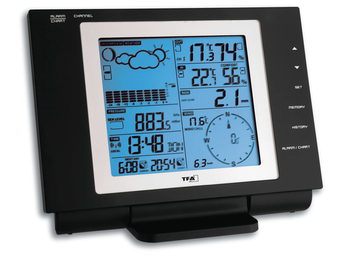Access data from a weather station with the Raspberry Pi
My new weather station [1] has several sensors for wind, rain, and temperature, as well as a USB cable and evaluation software (Figure 1), albeit a desktop-only Windows application. However, I wanted to record the measured data and, if possible, access it on my cell phone while I was on the move.
 Figure 1: The electronic TFA Nexus weather station records wind, rain, and outdoor temperature and outputs the data via USB. (Image: TFA Dostmann)
Figure 1: The electronic TFA Nexus weather station records wind, rain, and outdoor temperature and outputs the data via USB. (Image: TFA Dostmann)
Positioning a Windows PC running 24/7 next to my weather station was not an option; instead, I set my sights on the Raspberry Pi. Thus far, I had used it as a tiny media center with an equally tiny speaker, but by using its USB connection, my Pi could read the data output from the weather station. The power requirement is negligible compared with that of a full-size PC, and the Pi is silent. The question then arose: How can I acquire the data via USB if the station only comes with a Windows program?
[...]
Buy this article as PDF
(incl. VAT)
Buy Linux Magazine
Subscribe to our Linux Newsletters
Find Linux and Open Source Jobs
Subscribe to our ADMIN Newsletters
Support Our Work
Linux Magazine content is made possible with support from readers like you. Please consider contributing when you’ve found an article to be beneficial.

News
-
Wayland 1.24 Released with Fixes and New Features
Wayland continues to move forward, while X11 slowly vanishes into the shadows, and the latest release includes plenty of improvements.
-
Bugs Found in sudo
Two critical flaws allow users to gain access to root privileges.
-
Fedora Continues 32-Bit Support
In a move that should come as a relief to some portions of the Linux community, Fedora will continue supporting 32-bit architecture.
-
Linux Kernel 6.17 Drops bcachefs
After a clash over some late fixes and disagreements between bcachefs's lead developer and Linus Torvalds, bachefs is out.
-
ONLYOFFICE v9 Embraces AI
Like nearly all office suites on the market (except LibreOffice), ONLYOFFICE has decided to go the AI route.
-
Two Local Privilege Escalation Flaws Discovered in Linux
Qualys researchers have discovered two local privilege escalation vulnerabilities that allow hackers to gain root privileges on major Linux distributions.
-
New TUXEDO InfinityBook Pro Powered by AMD Ryzen AI 300
The TUXEDO InfinityBook Pro 14 Gen10 offers serious power that is ready for your business, development, or entertainment needs.
-
LibreOffice Tested as Possible Office 365 Alternative
Another major organization has decided to test the possibility of migrating from Microsoft's Office 365 to LibreOffice.
-
Linux Mint 20 Reaches EOL
With Linux Mint 20 at its end of life, the time has arrived to upgrade to Linux Mint 22.
-
TuxCare Announces Support for AlmaLinux 9.2
Thanks to TuxCare, AlmaLinux 9.2 (and soon version 9.6) now enjoys years of ongoing patching and compliance.

